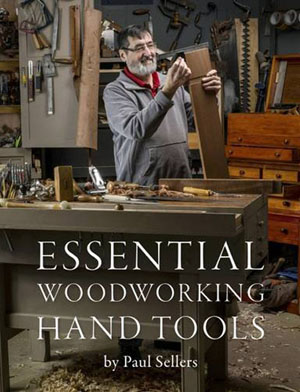|
Essential Woodworking Hand Tools
author and celebrated British woodworker Paul Sellers takes a different approach from many woodworking books in his latest title. Rather than presenting projects or describing techniques, he directs his attention to the tools he regards as essential to woodworking. His perspective is highly personal and reflects his taste for secondhand tools, particularly those made by Stanley and English maker Record. Though he also favors some modern makers' tools, he avoids mentioning them by name.
At more than 475 pages, the book provides ample space for thorough discussions of each tool. His treatment covers the features that are most desirable, how to restore and prepare the tools for use and techniques for getting the best results with them.
Following an early apprenticeship, Sellers has worked for 50 years as a woodworker, with heavy emphasis on hand tool use. His experience well qualifies him to share his seasoned opinions on the tools that function best and the features most desirable in them.
The book opens with sharpening gear, reflecting the importance of keeping tools at peak keenness. His preference in stones has evolved over the years, and he now favors diamond plates for their flatness and ease of maintenance. He is strongly devoted to finishing his tools with as many as 30-50 strokes on a strop. His treatment of sharpening gear extends to files for sharpening saw teeth, sawsets and burnishers for card scrapers.
The second major grouping of tools is used for laying out projects. He starts with squares and progresses to measuring tapes. Think you know all about these already? I did, and I was wrong. For example, the reason the tab at the end of a good measuring tape wiggles a bit is so it will automatically account for the thickness of the tab when the tape is hooked to the end of a board, thus ensuring an accurate reading. Who knew?
Though many of us have chosen single-bevel layout knives, his preference is for those with double bevels. He's comfortable using a pocket knife at times with one bevel held vertically against the ruler, arguing that it gives a more accurate knife line. He chooses a toothed marking gauge over a wheeled one.
He reviews a number of types of sliding bevel gauges and compares their advantages and disadvantages. An essential feature is the ability to lock the blade rigidly in place. The type of locking mechanism affects the position in which the gauge can be applied, so owning more than one may be desirable.
Chisels and gouges come next. Sellers discusses firmer chisels, bevel-edged chisels, mortise chisels and butt chisels. In his view, bevel-edge chisels are the most useful for woodworkers and firmer and butt chisels the least. After discussing sharpening and using chisels, he moves on to gouges. Sellers explains the numbering system for gouges and the methods he uses to keep them in top sharpness. Though useful, he finds them less often needed in woodworking than bevel-edge chisels.
The following section, on planes, is perhaps the most extensive and in many ways the most useful part of the book. Should you have one of every number of bench plane? Do you need a jointer plane for leveling? If you use power tools for milling or buy pre-milled wood, his answer is no. Most of his work is done with a #4 smoothing plane, even when jointing the edges of boards. Many of his planes are used Stanley's and other older planes he's refurbished, and he walks the reader through the restoration process.
His discussion of planes extends to spokeshaves, tools he employs daily in his work. He especially likes the Stanley 151, a bevel-down spokeshave, but his collection of many spokeshaves includes wooden bevel-up models as well. Bevel-up spokeshaves work best with relatively straight-grained wood, he finds, while the Stanley 151, when sensitively used, is better with difficult grain.
An extended section addresses plough planes. He especially likes the Record 043 and 044, as well as Stanley models. He also likes an unnamed modern plane that is probably his favorite. He spends time reviewing the characteristics of older wooden plough planes and sees advantages in their smoothness, especially those with wooden screws vs. those secured by wedges.
His discussion of planes ends with consideration of router planes and includes a description of how to make a serviceable "poor man's router plane."
Following sections address saws, including sharpening, handsaws, backsaws and coping saws. Scrapers are next, followed by rasps and files. He prefers and recommends hand-stitched rasps as giving the smoothest results. For the new user, he recommends starting with a 12-inch grain 10 cabinet rasp and a 7-inch grain 13 rasp, the grain indicating the degree of roughness of the rasps cut. Rasps come in right-hand and left-hand versions because of the angle at which the barbs are stitched. Among files, he recommends a 12-inch second cut file as the first purchase, which he finds useful for through tenons and smoothing chamfers.
Boring and drilling tools follow. After discussing braces and bits and hand drills, he compares types of awls. He argues that the square awl—also known as the birdcage awl—is the most useful for woodworkers to start and bore holes without splitting the wood, even near the end grain.
The final set of tools includes nylon hammers, steel hammers and mallets. He gives particular attention to crafting one's own wooden mallet, including discussion of wood selection, drying the wood and constructing a mallet to last a lifetime.
A brief final section on caring for hand tools is followed by a glossary.
This volume is liberally illustrated with excellent color photos throughout, as well as clear drawings by the author. Engagingly written, it is highly detailed and expresses Sellers' opinions based on his long experience. Because they reflect his personal preferences, you may not agree with all of them, but they are nonetheless well worth considering.
This book is an excellent resource that merits reading and using. It will be especially useful for newer hand tool woodworkers and those with hybrid workshops. In addition, it offers plenty of valuable information on selecting and restoring older tools and preparing them for use. This is a worthwhile addition to any woodworker's library.
Find out more about
Essential Woodworking Hand Tools
Purchase the
Essential Woodworking Hand Tools
Book and accompanying DVD set
Shop our great selection of Woodworking Hand Tools
J. Norman Reid is a woodworker, writer, and woodworking instructor living in the Blue Ridge Mountains with his wife, a woodshop full of power and hand tools and four cats who think they are cabinetmaker's assistants.
He can be reached by email at
nreid@fcc.net
.
|


